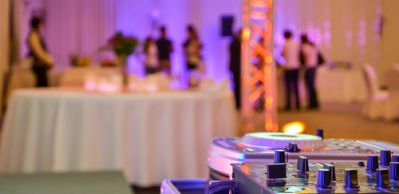 Let’s face it: Weddings can be expensive. Depending on who you ask, the average American nuptials cost anywhere between $29,000 to $45,000. With these hefty price tags, couples naturally look for ways to save money. If you’re a music lover, you may decide to DIY your reception tunes. From constructing your playlist to choosing the right equipment, you’ll need to follow some wise advice to make it happen.
Let’s face it: Weddings can be expensive. Depending on who you ask, the average American nuptials cost anywhere between $29,000 to $45,000. With these hefty price tags, couples naturally look for ways to save money. If you’re a music lover, you may decide to DIY your reception tunes. From constructing your playlist to choosing the right equipment, you’ll need to follow some wise advice to make it happen.
When To DIY and When To Go Pro
Martha Stewart Weddings’ Alyssa Brown points out the benefits and disadvantages of DIY wedding music. You have ultimate control over what gets played and what doesn’t. Also, you won’t have to cater to a drunk guest who wants to hear “Chicken Dance” or “Macarena.” On the flip side, you’ll have a harder time getting attendees to dance if the music doesn’t move them. You’ll also have a million other things grabbing your attention, so DIY music means you must handle playback and crowd issues yourself.
The Right Setup for the Right Sound
Going DIY can save you money, but you need the right kind of equipment. The Spruce’s Nina Callaway breaks down the two things you’ll need: a dependable digital player and a sound system to broadcast the music. Your digital source can be anything that has the storage and bandwidth to handle the task: a lightweight laptop, a tablet, a smartphone, or a portable MP3 player. Choose a streaming service or player that offers gapless playback or a crossfade feature.
As for the sound system, you’ll either have to use the venue’s in-house equipment or rent from an outside vendor. Callaway recommends a high-quality speaker system with an audio mixing board, a microphone, and the appropriate cables for connecting all these parts. Zola’s guide discusses the same type of equipment, adding the speakers should include two 12- to 15-inch units plus a subwoofer. NerdWallet’s Kelsey Sheehy mentions all these items, minus the mixing board.
Constructing Your Playlists
With your sound system in place, your next step is to create your wedding playlists. DIY Network’s Camille Styles recommends sitting down as a couple and discussing your plan and preferences first. Your conversation should include your music tastes and the evening’s order of events, along with special moments like toasts and dances. Also, make a list of your must-have tunes as well as anything that’s in your “do not play” category. While you’re at it, consider adding some favorites that your guests enjoy.
Since you want to evoke different moods throughout the evening, Zola advises crafting several different playlists. During cocktails, for example, you’ll want wedding music that’s ideal for ambiance and conversation. For reception introductions, try a list of upbeat songs. The dinner playlist can start with background music and slowly build up to more danceable tunes. To keep the evening flowing smoothly, Zola recommends choosing songs that are three minutes or less.
Last-Minute Tips To Remember
Once you’ve crafted your lists, you’re still not done. Listen through your selections once to fine-tune them, cutting any songs that don’t fit. You should also perform sound and equipment checks both before and on the wedding day itself to ensure sound quality, volume, and proper function. Consider choosing a master of ceremonies to operate your setup and make announcements throughout the evening. Finally, make sure you have sources for extra equipment, someone to call if you need help, and extra playlists in case the evening runs longer than expected.
Creating your DIY wedding music can be fun, but proper planning is vital. Take plenty of time to develop and fine-tune playlists that you and your guests will love. Choose high-quality sound equipment, and don’t forget to make a backup plan just in case something goes wrong. With these smart steps, you’ll have a successful reception music setup.
Add Your Comment